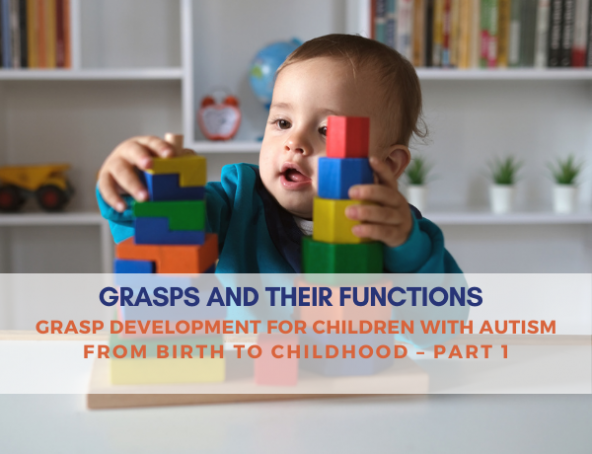Understanding Grasps and Functions

As parents, nurturing our children's development is a journey filled with learning and discovery. For parents of children with autism and other developmental disabilities, understanding and supporting grasp development can be particularly important. In this blog, we will explore the different types of grasps and their functions that are important to teach children as they develop.
Types of Grasps and Functions
Grasp development involves mastering various types of grips, each serving different purposes:
- Palmar Grasp: This instinctual grip involves the whole hand wrapping around an object, typical in early infancy.
- Pincer Grasp: As coordination improves, the ability to pick up small objects using the thumb and index finger emerges.
- Tripod Grasp: Utilizing the thumb, index, and middle fingers, this grip allows for precision and control, crucial for tasks like writing.
- Quadrupod Grasp: a functional 4-finger grasp on writing utensil where thumb, index, middle, and ring finger grasp onto utensil while pinky rest beneath utensil. This grasp allows for precision and control as well; it may also be used in place of tripod grasp for tasks such as writing.
Typical Development of Pencil/Writing Tool Grasp
Understanding the stages of grasp development provides insights into your child's progress:
- Infant Grasping: From reflexive movements to intentional actions, early grasping lays the foundation.
Example: When a newborn baby instinctively clasps onto their caregiver's finger when it is placed in their palm. This reflexive movement demonstrates the early foundation of grasp development, as the baby's hand closes around the object without conscious effort.
- Palmar Supination Grasp: Transitioning to voluntary grasping, hand-eye coordination starts to develop.
Example: As a baby grows, they begin to purposefully reach out to grab toys or objects within their reach. For instance, a six-month-old baby might reach out and grab a colorful rattle, demonstrating voluntary grasping. As they bring the toy closer to examine it, their hand-eye coordination starts to develop, laying the groundwork for more intentional interactions with objects
- Digital Pronate Grasp: Progressing towards precision, this stage enhances fine motor skills.
Example: As a toddler progresses in their grasp development, they may start using their fingers more precisely to manipulate objects. For instance, a two-year-old child might pick up small building blocks and stack them carefully, refining their fine motor skills. They might use their thumb and index finger to pick up individual blocks, demonstrating the progression towards precision grasping (pincer grasp) and enhancing their ability to engage in detailed tasks.
- Mature Tripod Grasp: Essential for writing and detailed tasks, achieving this grip marks a significant milestone.
Example: Imagine a four-year-old child sitting at a table, holding a crayon with their thumb, index, and middle fingers while drawing a picture. This mature tripod grasp allows them to control the crayon with precision, enabling them to create more intricate drawings and write letters or numbers more accurately. Achieving this grip marks a significant milestone in their fine motor skill development, setting the stage for further academic and creative endeavors.
By recognizing the different types of grasps and their functions, parents can provide tailored interventions and activities to promote their child's development. From the instinctual palmar grasp of infancy to the mature tripod grasp essential for writing, each stage represents a significant milestone in a child's journey towards independence and skill mastery. Through patience, encouragement, and targeted support, parents can empower their children on the autism spectrum to navigate the world with confidence and competence, fostering growth and development every step of the way.
To learn more about common delays in grasp development and activities to aid in overcoming them, be sure to check out Overcoming Challenges and Nurturing Grasp Development: Home-Based Activities to Improve Your Child's Grasp.
Contact our Family Support Team if you would like to learn how to get started with Occupational Therapy or any other programs and services that we offer. Our Family Support Team is always available to help and is available at no charge to all members of the autism and developmental disability community. Schedule a free phone appointment that works with your schedule: AZAunited.org/supportcall
You may also be interested in:
For more helpful resources and information, follow AZA United on social media:


.png)



